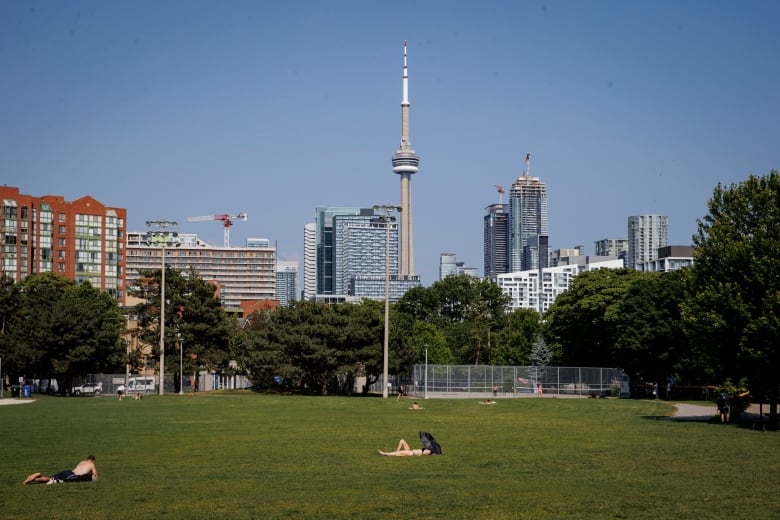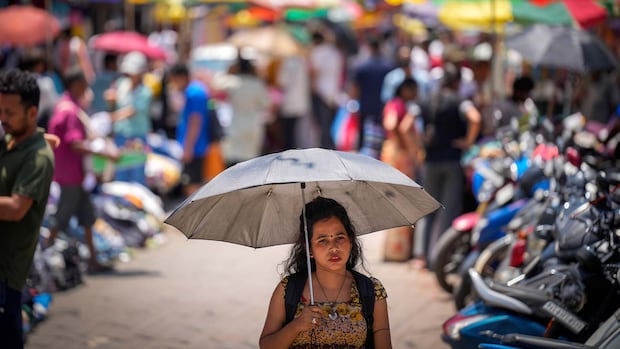Extreme heat is a global killer — and worse for our health than previously thought, new research shows
This story is part of CBC Health’s Second Opinion, a weekly analysis of health and medical science news emailed to subscribers on Saturday mornings. If you haven’t subscribed yet, you can do that by clicking here.
More than 1,000 people died as temperatures hit nearly 52 C during this year’s hajj in Saudi Arabia. Around 2,300 cases of heatstroke and dehydration were reported during Mexico’s recent stretch of extreme heat. Eight known deaths occured in just 72 hours amid India’s longest heatwave on record.
We’re only halfway through 2024, yet the global death toll from surging temperatures has been staggering, and a clearer picture is now emerging of extreme heat as one of the deadly emergencies facing regions around the world.
It’s no secret, of course, that high heat can kill you. Doctors have long warned that rising temperatures lead to conditions like heatstroke — a life-threatening medical emergency where your body simply can’t stop overheating — or exacerbate underlying illnesses like diabetes, asthma, or cardiovascular disease.
What’s new is just how many people are dying as global temperatures continue to rise, including across Canada and the northern U.S., where high heat previously wasn’t a top-of-mind concern.
More than 100 Canadian heat records were smashed on Wednesday alone, all while emerging research reveals the toll of high heat on the human body is far worse than previously thought.
“Most [Canadians] would probably take a look at these headlines and think, oh, it doesn’t really concern me,” said Toby Mündel, a Canada Research Chair in Extreme Human Environments and a professor of kinesiology at Brock University in St. Catharines, Ont.
“Not only is it going to happen to you, but it’s something that you can probably prepare for,” Mündel said.
Extreme heat days, deaths both rising
A report last month by leading climate scientists examined 76 extreme heat waves across 90 countries over a 12-month period starting in May 2023.
In that period, 6.3 billion people — roughly 78 per cent of the population — experienced at least 31 days of extreme heat that were “made at least two times more likely due to human-caused climate change,” the report said.
Andrew Pershing, vice-president of climate science at the U.S.-based Climate Central, one of the organizations behind the study, has been tracking the heat wave that blanketed a large part of the U.S. and eastern Canada over the past week.
“This whole region is experiencing at least one day that’s at Level 2 or Level 3, meaning it’s twice as likely or three times as likely because of climate change,” he said.
Such events, he said, “really signal how unusual this heat is, how there’s a really strong tie to carbon pollution in the atmosphere.”
Vulnerable populations, renters at higher risk
These catastrophic climate shifts are spiking hospitalizations and hitting vulnerable populations hardest, causing higher death tolls among marginalized communities and certain ethnic groups.
One national study from Statistics Canada looking at deaths related to extreme heat events — which are defined differently city to city — found that between 2000 and 2020, roughly 670 more deaths than usual were recorded in the country’s 12 largest cities during periods of extreme heat that lasted two days or longer, the research team said.

Cities where extreme heat events are less common saw the greatest spike in deaths, as did cities with more renters, which are less likely to have air conditioning.
South of the border, this year’s heat-related death report for New York City offered another granular look at who actually dies during periods of high heat.
Black individuals have death rates two times higher than people who are white, the report noted, due to economic, health care and housing divides stemming from “past and current structural racism.” The vast majority of people dying also have underlying health issues, with nearly nine in 10 heat deaths striking people with one or more chronic conditions.
Delhi has recorded a second straight day of record-breaking temperatures at 52.9 C, and red alert health notices have been issued for several parts of India due to extreme heat.
And the most important risk factor for heat-related deaths? Not having air conditioning, the New York team found. Among people exposed to heat in their own homes, zero deaths occurred between 2013 and 2022 among those with a working, operational AC, while every other death was among people who didn’t have access to a functioning AC unit.
Those findings echoed data from the sweltering 2021 heat dome in B.C., with researchers noting several striking trends among the province’s more than 600 heat-related deaths: many of the victims had chronic health conditions, the vast majority died in their homes and most of those at-home deaths were concentrated in lower-income neighbourhoods.
Serious health impacts
Heat waves have been linked to serious health effects, including higher suicide rates in the U.S. and Mexico, as well as higher rates of pre-term births in socioeconomically disadvantaged groups. Even the normal reaction of sweating can drive up the risk of heart attacks and strokes.
“We know that when we sweat a lot, our blood becomes thicker,” explains Dr. Matthew Bennett, a cardiologist and chair of the Canadian Cardiovascular Society’s planetary committee.
“With that increased concentration, there is a higher likelihood of clotting.”
New Canadian research, led by Daniel Gagnon at the Montreal Heart Institute, looked into what happens in the heart when body temperatures rise. By heating up participants slowly in a modified bodysuit, Gagnon scanned their hearts to see what was going on.
Gagnon saw “the amount of blood that goes to the heart increases substantially during heat exposure” and that it took as little as half a degree to get healthy hearts working “60 to 70 per cent” of maximum capacity.
In some participants with coronary artery disease — blockages of the main pathways into the heart — raising the body’s temperature led to ischemia, which Gagnon describes as a “mismatch” between the oxygen the heart needs versus what the blood vessels can supply. This can lead to arrhythmia, which is a known trigger of heart attacks.
When temperatures hit historic highs, it can affect every organ in the body as well as mental cognition. But what does that feel like? CBC’s Lauren Pelley visited a lab where it’s being studied to experience what happens when the body overheats.
Heat can also cause the body to develop edemas (swelling), rashes, cramps and more dangerous conditions like dizziness and vomiting. Worse still, doctors say symptoms can present as other illnesses.
“Heat stroke, for example, can look a lot like severe infections,” explained Dr. Anna Gunz, an intensive care pediatrician with Children’s Hospital at London Health Sciences Centre. The latter is far more common and therefore more likely to be chosen by a doctor as a diagnosis.
As climate change increases the frequency of these heat events, experts are calling for more awareness in the medical community of heat-related health issues, along with further studies to understand who’s most at risk.
Recent research does suggest there are unique health impacts on various groups. One Harvard team found heat increases the number of kids who visit emergency departments for any reason in the summer months, while another team studying pregnancy impacts recently identified links between higher temperatures and impaired fetal growth.
System-level solutions needed
What’s crucial going forward is for countries to develop a multi-pronged approach to keep various populations safe in hot weather, according to Dr. Caleb Dresser, an assistant professor of emergency medicine at Harvard Medical School and director of healthcare solutions for the university’s C-CHANGE centre for climate, health, and the global environment.
“Sometimes it’s individual-level, like knocking on your neighbour’s door to see how they’re doing in the heat,” he said. “Sometimes it’s system-level action… like research to know when heat turns dangerous, what populations are at risk.”
And, he added, those efforts need to be coupled with large-scale policy decisions, including aggressive reductions in fossil fuel use and greenhouse gas emissions, along with investments to ensure air conditioning and cooling centres become the norm.

On that front, there’s a growing movement in Toronto and elsewhere to legislate a maximum temperature in apartments, to ensure renters have access to a cool space.
Pershing, from U.S.-based Climate Central said unlike other extreme weather events made more common by climate change, the dangerous effects of heat are preventable.
“We know how to keep people cool,” he said. “And so it really is like a resource problem. It’s a system problem.”






